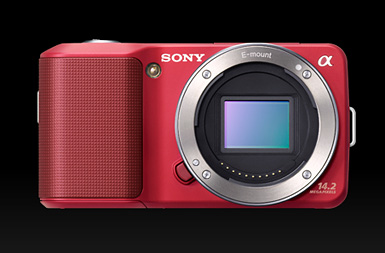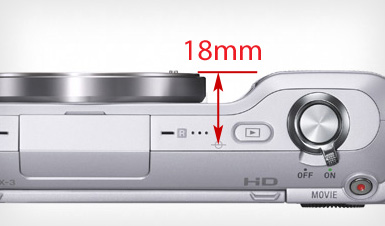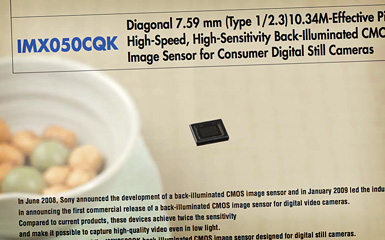Pentax: Sensors or Lenses?
May 30, 2010
On Pentaxian discussion boards, one dispute that absolutely refuses to die is whether Pentax will (or should) introduce a “full frame,” 24x36mm sensor DSLR.
The pleading for 24×36 often comes from those who might have already invested heavily in earlier FA lenses—meaning, ones originally designed to cover the old 135 film format.
I understand the emotion here—it’s quite true that an APS-C sensor wastes some of the capabilities of those lenses. And let’s take it as given that Pentax’s engineers would be fully capable of producing an excellent 24×36 camera.
But does Pentax “owe” its existing customers such a model?
BSI: No Panacea
May 21, 2010
In a few earlier posts I have mentioned the new generation of Sony sensors boasting “back-side illumination,” and marketed as Exmor-R (as distinct from Sony’s conventional sensors, just branded Exmor).
Back-side illumination (BSI in the industry jargon) is a tricky and costly chip-fabrication technique, where after depositing all the wiring traces on a silicon wafer, the substrate is flipped over and almost entirely thinned away. This leaves the wiring on the underside of the light-sensitive photodiodes (as Sony describes here), so these unobstructed pixels will theoretically collect more light.
BSI is promoted as one of the technological breakthroughs which might help save image quality, even as manufacturers race to cram more megapixels into tiny sensor areas. In fact, the IMX050CQK actually scaled back its pixel count to 10 Mp, compared to the 12 and 14 that have been becoming increasingly common in the point & shoot market.
Sony introduced the chip in its own first models in the fall of 2009, for example in the WX1. But clearly Sony found it advantageous to spread the sensor development costs over a larger production run, and apparently they’ve aggressively marketed the chip to other camera makers as well. Pretty much any 10 Mp camera sold this year advertising a backside-illuminated sensor uses it. It seems particularly popular in today’s nutty “Ultra Zoom” market segment.
So I was interested to read the review just posted by Jeff Keller of Nikon’s P100 ultrazoom camera, which uses this chip. See his conclusions here.
As reviews of these new BSI-based cameras filter out, the word seems to be that they do offer decent image quality—but hardly anything revolutionary. If their high-ISO images look smooth, it seems to be partly thanks to noise reduction processing, which can destroy detail and add unnatural, crayon-like artifacts.
A Nameless EVIL
May 13, 2010
The introduction of Sony’s NEX-3 and NEX-5 has once again thrown a weird anomaly into sharp relief.
Even 20 Months after the introduction of the Panasonic G1, there is still no universally-agreed-upon term for this new class of cameras.
The defining aspects of the genre are a largish sensor size (as compared to typical compacts) plus interchangeable lenses. Yet by omitting any reflex viewfinder, and instead streaming a live digital image from the sensor, the body size can be reduced from the bulk of conventional DSLRs.

Name that Evil
Now, the most widely-known term (and the one I use) is “EVIL,” meaning “electronic viewfinder, interchangeable lens.”
A few pedants object that the Olympus E-P1 does not have a “viewfinder” in the sense of something you hold up to your eyeball (nor do the Sony NEX models, so far). But you can slightly revise the phrase to be “electronic viewing” instead, if this bothers you.
Sony: Less EVIL Than Feared
May 11, 2010
Well, the much-anticipated “EVIL” cameras from Sony have finally arrived, the NEX-3 and NEX-5.

Big Sensor, Small Camera
The fullest NEX-5 review available so far is at Imaging Resource (while DP Review has vented annoyance that they were given pre-production cameras, and so were forbidden to publish test images).
The clearest win for the NEX system is in body size—which (for an interchangeable-lens, APS-C camera) is quite impressive. I hope all the other EVIL brands are paying very close attention.
The tiny NEXes also make it apparent that zoom lenses become even more ridiculous in the EVIL segment: Compact primes are the obvious way to capitalize on the mirrorless size advantage.
So it’s a mystery that the sole pancake prime offered at launch is a very wide 16mm f/2.8 (24e). Sony clearly needs to fill out its lens lineup still—at least adding a fast “normal” lens (approximately 30mm for the APS-C sensor format).
But perhaps they needed more time to complete something competitive with Panasonic and Samsung’s well-regarded pancakes. Sony’s tiny ultrawide stands alone here, and will admittedly be intriguing for many shooters.
Sony could not resist stuffing in a few more superfluous megapixels: These models use a 14 Mp sensor. But the high-ISO results seem very decent. Not quite class-leading (even compared to Sony’s own 12 Mp sensors used in the Nikon D5000 or the Pentax K-x); but it’s clear that Samsung’s 14 Mp sensor from the NX10 is being left in the dust.
I can tell from Petavoxel’s site traffic that the Samsung NX-10 generated much curiosity wondering if it could accept an adapter for Leica-mount lenses, in M bayonet or 39mm thread. (The answer seems to be no, unless someone can show me otherwise.) But the story for Sony’s new “E” lens mount is much more interesting:

Shallowest Lens Mount EVAR?
Thanks to Sony for providing that handy sensor-plane mark on the NEX-3. Scaling from the published body dimensions, this is one incredibly shallow lens mount. (The throat diameter is pretty generous too, from what I can estimate). Even for the shallow lens register of Leica lenses, there’s about a centimeter of extra depth to allow a lens adapter.
So the good news is that mechanically, it would be possible to adapt just about any other lens to the E mount. What we don’t know yet is whether Sony will intentionally cripple this function, either by requiring a Sony-chipped lens to be attached or by having poor support for manual focusing.
The user interface of these new NEX cameras follows in the footsteps of the Olympus E-PL1, in being very “point & shoot” oriented. There is no tactile function wheel for manual control, a major downer for any serious user. It remains to be seen whether Sony expands the NEX lineup into “enthusiast” models with better manual controls.
Also mystifying is the lack of an optional eye-level electronic viewfinder. Sony has created a new proprietary accessory port, but currently it is only used for the (included) companion flash, an optical viewfinder for the superwide lens, and a video microphone. It seems impossible that Sony would deliberately handicap themselves by not including connectors for an EVF as well; so I guess we should assume that will come later.
I do respect Sony’s decision to keep the flash separate, given that ISO 1600 shooting seems quite acceptable with this NEX sensor. But again, it does make one wonder whether Sony has a brighter-than-f/2.0 lens option waiting in the wings somewhere.
Whither Pentax?
May 7, 2010
I guess this was the week for Pentax’s European executives to go rogue.
Hiroshi Onoda made some comments to the Spanish Pentaxeros website, hinting at future “more professional” DSLRs (google translation). Then, Stephen Sanderson told the UK’s Amateur Photographer that Pentax “hadn’t ruled out” a mirrorless, EVIL model.
Both statements were vague and ambiguous enough to set off a storm of speculation on Pentaxian discussion boards. Many hearts fluttered, imagining Pentax might introduce a DSLR based on a 24 x 36mm “full frame” sensor; others wondered whether they might join Olympus and Panasonic in the Micro Four Thirds camp.

Pentax Surprises Ahead?
But there’s two key facts that must always be remembered about Pentax:
- They do not make their own sensor chips
- Last year, the company almost went under
At PMA 2010, Pentax USA president Ned Bunnell gave an interview with Imaging Resource. He said plainly that Hoya, Pentax’s new corporate owners, were demanding more focus on the bottom line, and a clearer marketing strategy.
So, Pentax simply cannot build every camera its fanbase thinks might be cool.
Zooms—The Silent Killer
May 4, 2010
Despite endless technological evolution, one photography convention has endured for more than a century: Our numbering system for lens apertures. That is, the familiar “f-stop” scale:
1.4 2 2.8 4 5.6 8 11 16 22
This sequence is admittedly peculiar-looking, and it always confuses beginners. Why do larger numbers mean smaller-diameter lens openings?
But as many of you are aware, these numbers are actually “f/ratios“—that is, they’re the ratio of a lens’s focal length to the aperture diameter. Setting a lens to f/4.0 means its aperture opening measures one-fourth of the focal length.

